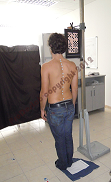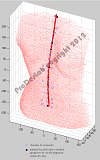Human back symmetry line from 3d scanned data
Techniques for analysis of the spine's spatial configuration have been subject of studies to allow the operators to provide diagnosis with increasing accuracy in terms of quantity and quality of those are most important and widespread congenital or postural rachis pathologies (scoliosis, dorsal kyphosis, lumbar hyperlorodsis...etc).
Traditionally techniques for diagnosis of pathologies or injuries of vertebral column are still carried out through devices that exploits radiations emission for internal investigations (X-rays, Computer Tomography) or by tactile approach, based on tactile detection, which consists in fixing appropriate markers in correspondence of apophyses, for external investigations.
Principal defectiveness of above methods are:
- X-rays:
- do not give as result three-dimensional configuration of rachis so they just give planar projection of spine;
- expose patient to radiations;
- need high execution time;
- do not make possible to determine with precision vertebral rotation.
- CT:
- expose patient to heaviest load of radiation;
- need high execution time.
- Tactile approach-based methods:
- just allow qualitative operator's estimation;
- need high execution time.
Our approach
More recently, to improve results quality and to reduce risks of over - exposure to X - rays, thanks to advent of three - dimensional geometric acquisition techniques, research studies have been addressed to develop methodologies, involving raster - stereography devices, that evaluate postures starting from external detection and can provide as a result the spatial representation of the vertebral column, which is typically called symmetry line.
Principal advantages, from their use, are:
Actually commercial products mainly present two limitations:
- external evaluation of the posture, so they can be considered non - invasive methods with respect of radiations - based methods;
- they can evaluate postures with low - time process;
- the evaluation process is semi - automated and the error introduced by the operator is lower than relative to above mentioned methods;
- they allow estimation of principal characteristic elements to (trunk length, trunk inclination, kyphotic angle, lordotic angle... etc).
In order to overcome just illustrated limitations we have elaborated a new algorithm to detect symmetry line in several postures also in the case in which symmetry line falls out from sagittal plane thanks the evaluation of indexes that make the method less affected by acquisition process. These improvements allow our method giving information about the posture correctness assumed by the subject not only in the case of upright posture but also in those closer to workers postures in the workplace. The complex anatomy of the musculoskeletal system in fact, characterized by a high number of degrees of freedom, gives rise to assume several postures. However, not all of them are necessarily correct postures. Assuming incorrect postures for a long period of time generates musculoskeletal injuries. Moreover recent studies have demonstrated that extreme or incorrect postures have to be considered one of the greater risks for musculoskeletal lesions and the most prevalent work-related reason for work absence in many industries.
- uncertainties inherent in the methods which evaluate differential quantities of second order;
- possibility to detect rachis spatial configuration only in case of upright postures or affected by light pathologies that do not make falling spine far outside the sagittal plane.
In the following figures a screenshots (click to enlarge) of results obtained by our method.
Details of our method are reported in:
 Di Angelo L., Bella R, Di
Stefano P, Danubio M.E., Vinciguerra M.G., "The analysis of posture
by means of a geometric method for the determination of the simmetry
line of the vertebral column" , In Proceeding of International
congress of EUFAPA, October 9 - 11 2008, Torino, Italy.
Di Angelo L., Bella R, Di
Stefano P, Danubio M.E., Vinciguerra M.G., "The analysis of posture
by means of a geometric method for the determination of the simmetry
line of the vertebral column" , In Proceeding of International
congress of EUFAPA, October 9 - 11 2008, Torino, Italy.- Di Angelo L., Di Stefano P., Raimondi P., Vinciguerra M. G., "Validation of a method for symmetry line detection", In Proceeding of XX International Conference of Graphic Engineering, June 4 - 6 2008, Valencia, Spain, ISBN: 978-84- 8363-275-8.
 Di Angelo L., Di Stefano P.,
Spezzaneve A., "Symmetry line detection for non-erected postures".
In: Proceedings of IDMME - Virtual Concept 2010, October 20 - 22
2010, Bordeaux, France, ISBN: 978-2-8178-0168-1.
Di Angelo L., Di Stefano P.,
Spezzaneve A., "Symmetry line detection for non-erected postures".
In: Proceedings of IDMME - Virtual Concept 2010, October 20 - 22
2010, Bordeaux, France, ISBN: 978-2-8178-0168-1. Di Angelo L., Di Stefano P.,
Vinciguerra M.G., "Experimental validation of a new method for
symmetry line detection". Computer - Aided Design and Applications,
vol. 8 (1), 2011, p. 71-86, ISSN: 1686-4360.
Di Angelo L., Di Stefano P.,
Vinciguerra M.G., "Experimental validation of a new method for
symmetry line detection". Computer - Aided Design and Applications,
vol. 8 (1), 2011, p. 71-86, ISSN: 1686-4360.-
 Di Angelo L., Di Stefano P.,
Spezzaneve A., "An iterative method to detect symmetry line falling
far outside the sagittal plane". International Journal on
Interactive Design and Manufacturing (in press), ISSN: 1955-2513.
Di Angelo L., Di Stefano P.,
Spezzaneve A., "An iterative method to detect symmetry line falling
far outside the sagittal plane". International Journal on
Interactive Design and Manufacturing (in press), ISSN: 1955-2513.  Di Angelo L., Di Stefano P.,
Spezzaneve A., "A method for 3D detection of symmetry line in
asymmetric postures". Computer Methods in Biomechanics and
Biomedical Engineering (in press), ISSN: 1025-5842.
Di Angelo L., Di Stefano P.,
Spezzaneve A., "A method for 3D detection of symmetry line in
asymmetric postures". Computer Methods in Biomechanics and
Biomedical Engineering (in press), ISSN: 1025-5842.

